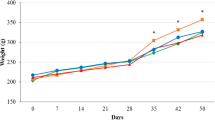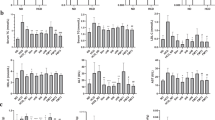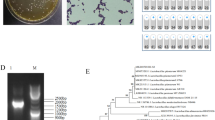Abstract
We have previously reported that live Bifidobacterium longum SPM1207, a strain isolated from healthy adult Koreans, significantly reduced serum cholesterol in broth and rat. We here examined the effect of oral administration of sonication-killed B. longum SPM1207 on serum cholesterol in rats in order to investigate whether this killed strain could be utilized as a potent probiotics for human and animals. Dietary treatments consisted of 3 treatment groups of 24 rats each randomly assigned to either normal diet, high cholesterol diet and saline (HCS), or high cholesterol diet and sonication-killed B. longum SPM1207 (HCKB) for 3 weeks. Although HDL-cholesterol levels in the serum were not significantly (p > 0.05) different between HCKB rats and HCS rats, total and LDL-cholesterol levels in the serum were significantly (p < 0.05) less increased in HCKB (total: 177.71 mg/dL, LDL-: 60.50 mg/dL) rats when compared to HCS (total: 237.17 mg/dL, LDL-: 71.50 mg/dL) rats. AI was significantly (p < 0.05) lower in HCKB (4.95 mg/dL) rats when compared to HCS (9.22 mg/dL) rats. Body weight increase and relative liver weight were significantly (p < 0.05) lower in HCKB rats when compared to HCS rats. Over the time, high cholesterol diet caused dry feces accompanied by decreased fecal water content (66.00 to 61.94%) but sonication-killed B. longum SPM1207 administration increased fecal water content (71.58 to 74.25%). The results in the current study provide evidence that the sonication-killed cells of B. logum SPM1207 isolated from healthy adult Koreans have a greater potential to be used as a cholesterol-lowering agent. Furthermore, the current study suggest that this killed specific strain may play role in part in blocking the body weight increase and relieving or eliminating constipation.
Similar content being viewed by others
References
Abot, R. D., Wilson, P. W. B., and Castelli, W. P., HDL-cholesterol, total cholesterol screening and myocardial infarction. Arteriosclerosis, 8, 207–211 (1988).
Ahn, J. B., Isolation and characterization of Bifidobacterium producing exopolysaccharide. Food Eng. Prog., 9, 291–296 (2005).
Anderson, J. W. and Gilliland, S. E., Effect of fermented milk (yogurt) containing Lactobacillus acidophilus L1 on serum cholesterol in hypercholesterolemic humans. J. Am. Coll. Nutr., 18, 43–50 (1999).
Bevilacqua, L., Ovidi, M., Di Mattia, E., Trovatelli, L. D., and Canganella, F., Screening of Bifidobacterium strains isolated from human faeces for antagonistic activities against potentially bacterial pathogens. Microbiol. Res., 158, 179–185 (2003).
Chandan, R. C., Enhancing market value of milk by adding cultures. J. Dairy Sci., 82, 2245–2256 (1999).
Danielson, A. D., Peo, E. R. Jr., Shahani, K. M., Lewis, A. J., Whalen, P. J., and Amer, M. A., Anticholesteremic property of Lactobacillus acidophilus yogurt fed to mature boars. J. Anim. Sci., 67, 966–974 (1989).
Gilliland, S. E., Nelson, C. R., and Maxwell, C., Assimilation of cholesterol by Lactobacillus acidophilus. Appl. Environ. Microbiol., 49, 377–381 (1985).
Harrison, V. C. and Peat, G., Serum cholesterol and bowel flora in the newborn. Am. J. Clin. Nutr., 28, 1351–1355 (1975).
Hepner, G., Fried, R., St. Jeor, S., Fusetti, L., and Morin, R., Hypocholesterolemic effect of yogurt and milk. Am. J. Clin. Nutr., 32, 19–24 (1979).
Kim, D. W., Yang, D. H., Kim, S. Y., Kim, K. S., Chung, M. G., and Kang, S. M., Hypocholesterolemic effects of lyophilized, heat-killed Lactobacillus rhamnosus and Lactobacillus plantarum. Kor. J. Microbiol. Biotechnol., 37, 69–74 (2009).
Klaver, F. A. M. and Van der meer, R., The assumed assimilation of cholesterol by Lactobacilli and Bifidobacterium bifidum is due to their bile salt-deconjugating activity. Appl. Environ. Microbiol., 59, 1120–1124 (1993).
Klein, G., Pack, A., Bonaparte, C., and Reuter, G., Taxonomy and physiology of probiotic lactic acid bacteria. Int. J. Food Microbiol., 41, 103–125 (1998).
Law, M. R., Wald, N. J., Wu, T., Hackshaw, A., and Bailey, A., Systematic underestimation of association between serum cholesterol concentration and ischaemic heart disease in observational studies: data from BUPA study. Br. Med. J., 308, 363–366 (1994).
Lee, D. K., Jang, S., Baek, E. H., Kim, M. J., Lee, K. S., Shin, H. S., Chung, M. J., Kim, J. E., Lee, K. H., and Ha, N. J., Lactic acid bacteria affect serum cholesterol levels, harmful fecal enzyme fecal activity, and fecal water content. Lipids Health Dis., 8, 21 (2009).
Lee, Y. W., Roh, W. S., and Kim, J. G., Benefits of fermented milk in rats fed by hypercholesterolemic diet (II). Kor. J. Food Hyg., 7, 123–135 (1992).
Lora, K. R., Morse, K. L., Gonzalez-Kruger, G. E., and Driskell, J. A., High saturated fat and cholesterol intakes and abnormal plasma lipid concentrations observed in a group of 4- to 8-year-old children of Latino immigrants in rural Nebraska. Nutr. Res., 27, 483–491 (2007).
Mann, G. V. and Spoerry, A., Studies of a surfactant and cholesterolemia in the Massai. Am. J. Clin. Nutr., 27, 464–469 (1974).
Mann, G. V., A factor in yogurt which lowers cholesteremia in man. Atherosclerosis, 26, 335–340 (1977).
Manson, J. E., Tosteson, H., Ridker, P. M., Satterfield, S., Hebert, P., and O’Connor, G. T., The primary prevention of myocardial infarction. N. Engl. J. Med., 326, 1406–1416 (1992).
Park, O. J., Plasma lipids and fecal excretion of lipids in rats fed a high fat diet, a high cholesterol diet or a low fat/high sucrose diet. Kor. J. Nutr., 27, 785–794 (1994).
Prasad, J., Gill, H., Smart, J., and Gopal, P. K., Selection and characterisation of Lactobacillus and Bifidobacterium strains for use as probiotics. Int. Dairy J., 8, 993–1002 (1998).
Roos, M. N. and Martin, K. B., Effects of probiotic bacteria on diarrhea, lipid metabolism, and carcinogenesis: a review or papers published between 1988 and 1998. Am. J. Clin. Nutr., 71, 405–411 (2000).
Ross, R., The pathogenesis of atherosclerosis: a perspective for 1990s. Nature, 362, 801–809 (1993).
Scardovi, V., Genus Bifidobacterium. In N.R. Krieg and J. G. Holt (Eds.). Bergey’s Manual of Systemic Bacteriology, Vol. 2, Williams & Willikins, MD, pp. 1418–1434, (1986).
Schaafsma, G., Meuling, W. J., van Dokkum, W., and Bouley, C., Effects of a milk product, fermented by Lactobacillus acidophilus and with fructo-oligosaccharides added, on blood lipids in male volunteers. Eur. J. Clin. Nutr., 52, 436–440 (1998).
Segawa, S., Wakita, Y., Hiroshi, H., and Watari, J., Oral administration of heat-killed Lactobacillus brevis SBC8803 ameliorates alcoholic liver disease in ethanol-containing diet-fed C57BL/6N mice. Int. J. Food Microbiol., 128, 371–377 (2008).
Tahri, K, Grill, J. P., and Schneider, F., Bifidobacteria strain behavior toward cholesterol: Coprecipitation with bile salts and assimilation. Curr. Microbiol., 33, 187–193 (1996).
Tannock, G. W., Analysis of the intestinal microflora: a renaissance. Antonie Van Leeuwenhoek, 76, 265–278 (1999).
Theuwissen, E. and Mensink, R. P., Water-soluble dietary fibers and cardiovascular disease. Physiol. Behav., 94, 285–292 (2008).
Vetvicka, V., Vashishta, A., Saraswat-Ohri, S., and Vetvivkova, J., Immunological effects of yeasts- and mushroom-derived β-glucans. J. Med. Food, 11, 615–622 (2008).
Xiao, J. Z., Kondo, S., Takahashi, N., Miyaji, K., Oshida, K., Hiramatsu, A., Iwatsuki, K., Kokubo, S., and Hosono, A., Effects of milk products fermented by Bifidobacterium longum on blood lipids in rats and healthy adult male volunteers. J. Dairy Sci., 86, 2452–2461 (2003).
Author information
Authors and Affiliations
Corresponding author
Rights and permissions
About this article
Cite this article
Shin, H.S., Park, S.Y., Lee, D.K. et al. Hypocholesterolemic effect of sonication-killed Bifidobacterium longum isolated from healthy adult Koreans in high cholesterol fed rats. Arch. Pharm. Res. 33, 1425–1431 (2010). https://doi.org/10.1007/s12272-010-0917-7
Received:
Revised:
Accepted:
Published:
Issue Date:
DOI: https://doi.org/10.1007/s12272-010-0917-7




